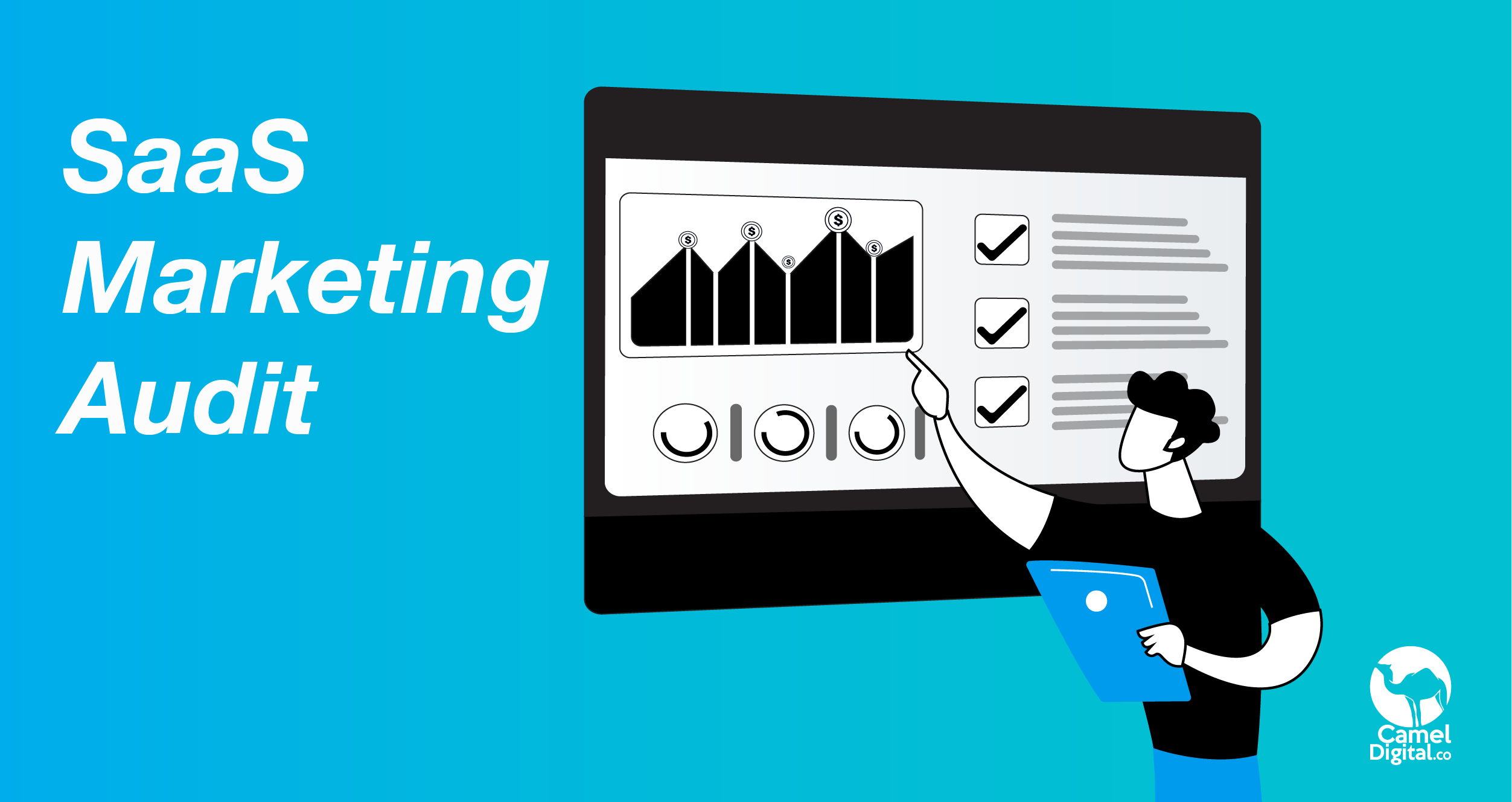Marketing is full of uncertainty. Even if you’re an expert running the same playbook in a familiar industry, there’s no guarantee it will work again. That’s why SaaS teams can’t just rely on plans on paper. They need proof from real users, real markets, and real budgets.
A SaaS marketing audit is how you test, adjust, and make sure your strategy turns into actual growth. Like tasting a dish while cooking, you don’t wait until the end. You check along the way.
A SaaS marketing audit does exactly that for your campaigns:
- Track real sign-ups, not just clicks.
- Follow ad spend to paying users.
- Spot wasted budget or weak pages.
Here’s how a SaaS marketing audit turns a solid-looking plan into measurable results.
What Is the Purpose of a SaaS Marketing Audit?
Sometimes the biggest surprise in marketing isn’t what you missed in planning but what slips through in execution. A SaaS marketing audit helps you spot those gaps before they cost you results.
Spotting the Hidden Problems
Even if you follow the playbook, hidden issues can still slow you down. Your strategy may target the wrong audience, or your budget gets locked into campaigns that never convert. Sometimes it’s even smaller mistakes, like a form that doesn’t work, tracking that misses sign-ups, or ads showing in the wrong places.
Content audit for SaaS helps you catch these problems early so they don’t grow into bigger losses.
Benchmarking Current Performance
Your blogs, ads, landing pages, and sign-up flows may all be running, but do you know how well each piece actually performs? Benchmarking your current performance means taking a clear snapshot of everything: how your content brings people in, how your funnel moves them from visitor to trial, how your pages convert them, and how your paid campaigns support it all.
With these numbers in front of you, you can see what’s strong, what’s weak, and where to focus your energy for real improvement.
Aligning Efforts With Goals
Busy campaigns don’t always mean progress. The real test is if your marketing connects to your goals. Do your strategies drive the sign-ups, demos, or paying users you actually need?
A SaaS marketing audit makes sure your efforts line up with both the company’s growth targets and the real needs of your market. When those two connect, every dollar and every hour spent has a clear purpose.
Investing in Tools and Resources That Truly Work
Most SaaS companies rely on project trackers, analytics dashboards, and ad platforms. But not every tool makes life easier, and not every investment pays off.
A SaaS marketing audit takes a hard look at if the tools you use actually simplify your workflow and whether your budget and resources are placed where they create real impact.
When Should You Conduct a SaaS Content Audit?
There’s no single rule for timing. It depends on how your marketing runs and how fast things change in your business.
Sometimes it’s enough to check small parts, like if your tracking works properly, if your ads match the right audience, or if a landing page still converts. Other times, you need a bigger review, like looking at the whole funnel from first click to paying customer or checking if all your tools and spend align with business goals.
That said, running a full audit at least once a year is recommended. Doing it twice a year or even quarterly is more effective, especially if you update your marketing strategy regularly.
But if a SaaS marketing audit isn’t yet part of your routine, there are clear red flags that shout it’s time to stop and take a closer look at what stopped working.
Alert 1: Traffic Stalls or Conversion Rates Drop
From years in B2B SaaS marketing, we can tell you this is the single biggest red flag you cannot ignore. Traffic and conversion rates are the heartbeat of your funnel. If one slows down, the whole system suffers. When traffic stalls, it often means your channels are no longer reaching the right people, your messaging has gone stale, or competitors are eating into your visibility.
And when conversion rates drop, that’s an even sharper warning: either the audience doesn’t connect with your offer anymore, your landing pages are leaking sign-ups, or your follow-up process isn’t doing its job.
The danger is that teams usually react by pushing more budget into the same campaigns, hoping volume will fix the problem. It never does.
With a SaaS marketing audit, you can see if the issue is awareness, intent, or the handoff to sales. It also gives you a clear recovery plan instead of wasted spend.
Alert 2: Pre-Scale or Funding Rounds
When you are heading into a funding round or preparing to scale, a SaaS marketing audit becomes a safety check for your growth engine. Investors look beyond revenue and want to see that your growth model is both efficient and repeatable. They will ask about CAC, payback periods, funnel conversion rates, and the reliability of your marketing data.
Going in without an audit is risky. Even small leaks like misattributed sign-ups, inflated conversion numbers, or unclear ROI from campaigns can raise doubts about your results and weaken your position. An audit ensures your data is clean, your marketing spend is tied directly to customer growth, and your team can answer tough investor questions with confidence. It provides the clarity and trust you need before putting your growth story under scrutiny.
Alert 3: Before Launching New Campaigns or Repositioning
Every new campaign or repositioning effort relies on the foundation you already have in place. If your tracking isn’t set up right, if the audience you reach isn’t the one you want, or if people keep dropping off halfway through the funnel, those issues will only follow you into the new launch.
A SaaS marketing audit gives you a clear baseline before you roll out changes. It confirms that your data is accurate, your funnel can handle increased traffic, and your messaging effectively connects with the target audience. Starting with this clarity prevents wasted spend and helps your new direction gain results faster.
Alert 4: After Algorithm or Product Changes
Platforms like Google, LinkedIn, or Meta change their algorithms often, and each update can affect how your campaigns perform. Sometimes it means your ads stop reaching the same audience, or your best-performing content suddenly loses visibility.
The same goes for big product updates or new feature launches. They can change what your audience expects, shift the way you position value, and even make old messaging feel outdated overnight.
A SaaS marketing audit helps you quickly see where these shifts impact your SaaS marketing funnel and what needs fixing before results slip further.
What to Expect from a SaaS Marketing Audit Report
Every audit report looks different because every company tracks different things and asks various questions. Some focus heavily on paid ads, others lean more on content or SEO, and many still struggle with clean tracking.
The shape of the report depends on what you measure and what you need to know. But the core idea is always the same: understand what is happening with your marketing results, why it’s happening, and what should be done to change it into the results you actually want.
Here’s what you’ll usually see in a SaaS marketing audit report:
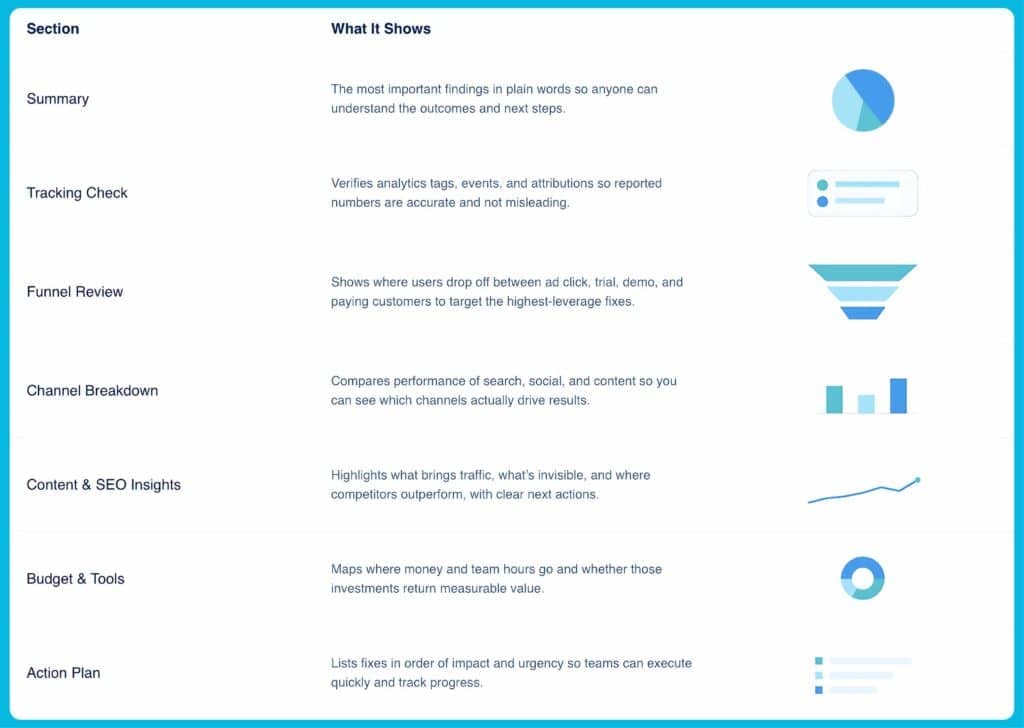
Core Areas of the Audit
On the SEO and content side, the report highlights which keywords bring traffic, where you lose ground to competitors, and if your most important pages (like comparison or integration pages) actually rank where they should.
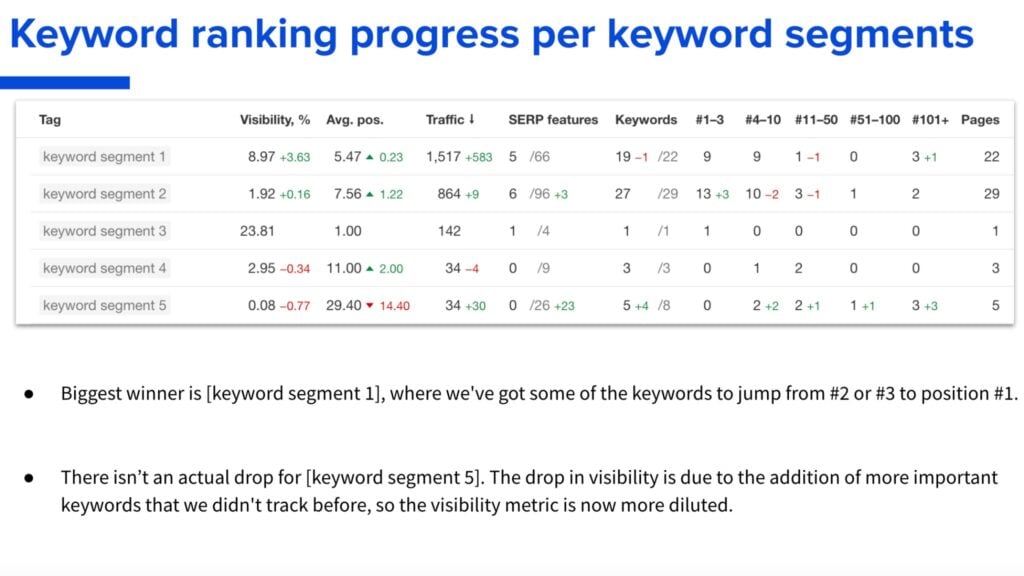
You might see, for example, that many non-brand keywords sit just outside the top 10 or that a blog post driving traffic brings almost no qualified leads.
Next comes conversion rate optimization (CRO), where the report shows how effectively visitors turn into sign-ups or demos. A landing page may look good but have a 1% conversion rate, or a mobile form may cause drop-offs halfway through. These are the small leaks that quietly cost customers.
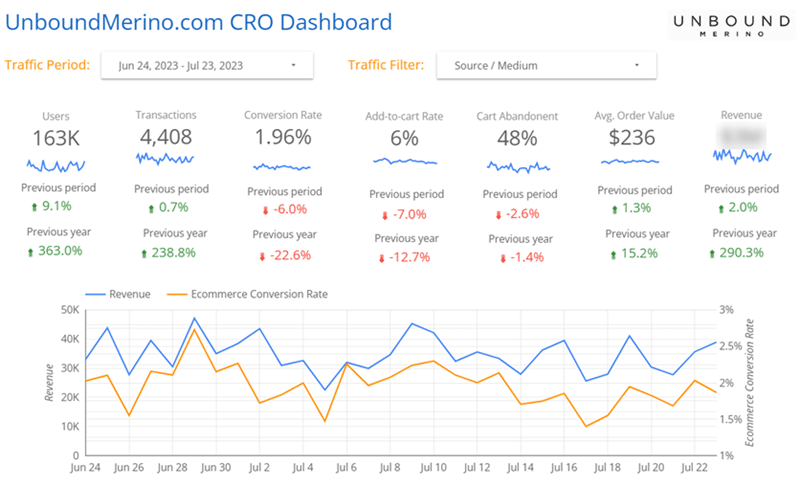
The paid campaign analysis section focuses on budget efficiency. It reveals whether ad spend goes to the right queries or audiences, and if ads and landing pages match in message. For instance, the report might show that 25% of the spend goes to broad-match keywords that never convert or that LinkedIn ads bring clicks but no trials.
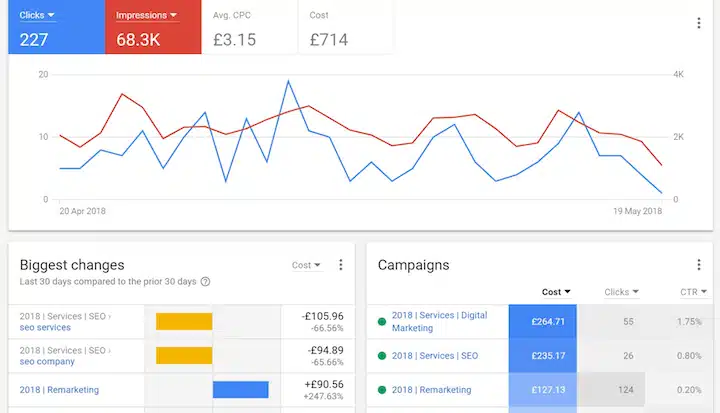
Then comes funnel mapping, which connects every step from ad click to paying customer. This makes it clear where people drop off. Maybe trials don’t book demos, or demos don’t turn into opportunities. By seeing the funnel as a whole, you can measure not just traffic but how it actually translates to revenue.
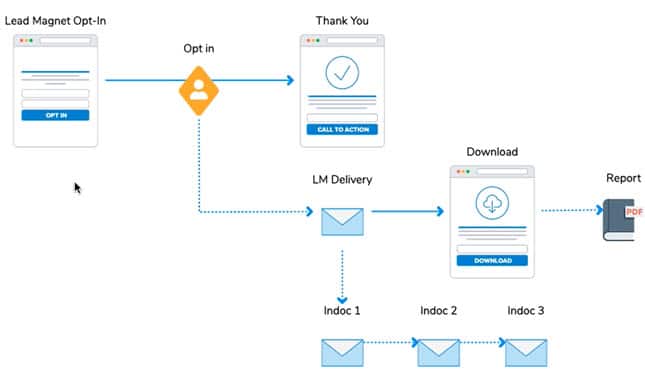
Wins and Problems to Fix Urgently
The most valuable part of any SaaS marketing audit is how it connects results directly to ROI and business goals. Metrics on their own don’t matter. Clicks, impressions, or even trial sign-ups look good on paper but mean little if they don’t lead to paying customers and predictable revenue.
A well-done audit connects every metric back to outcomes like CAC, payback period, and pipeline contribution. For example, instead of simply noting that a landing page converts at 2%, the report shows what that 2% means in cost per customer and how it aligns with your target CAC.
This is also where the SaaS marketing budget discussion comes in. An audit doesn’t just review performance; it checks if the spend is aligned with priorities. Are you investing in channels that bring the right customers, or overfunding campaigns that inflate vanity metrics? For instance, you may find 25% of the budget going to low-intent keywords with poor trial-to-paid rates, while higher-quality campaigns are underfunded.
By tying insights back to ROI and budget allocation, the audit helps leadership make confident decisions. It shifts marketing from a cost center into a growth engine that supports revenue targets and investor expectations.
SaaS Audit Best Practices Checklist
An audit only works if the right data is in place from the start. You need to track sign-ups, demos, conversions, ad spend, and funnel steps so the report shows a full picture of performance.
Just as important is attribution. Without it, you can’t see which campaigns drive customers, and budget decisions turn into guesswork. With proper attribution, every dollar spent can be traced back to real impact.
Assuming everything is well set up, here’s the SaaS audit checklist you can adapt to your goals, resources, and current challenges.
Define Your ICP, UVP, and Positioning
Think of marketing as a simple chain of three links.
First, there’s the ideal person who needs your product.
Then there’s the value they want from you.
And finally, there’s the way you communicate that value so they actually believe and act on it.
If any link is weak, the whole chain breaks. That’s why, before you even start an audit, you should carefully define these three things.
- Who is your ICP (Ideal Customer Profile)? For example, are they mid-size SaaS companies in the U.S. with 50–200 employees, or enterprise IT managers in EMEA? Has this changed in the last year as your product evolved?
- What is the UVP (Unique Value Proposition) they want and you deliver? Maybe it’s “reduce churn by predicting user drop-off 30 days earlier” or “cut reporting time from hours to minutes.” Ask if it’s strong, measurable, and clear.
- What’s your positioning and messaging? How do you package and push your value to that ICP? Is it formal, data-driven messaging aimed at CFOs, or simple, user-friendly language for startups? This is where style matters as much as content.
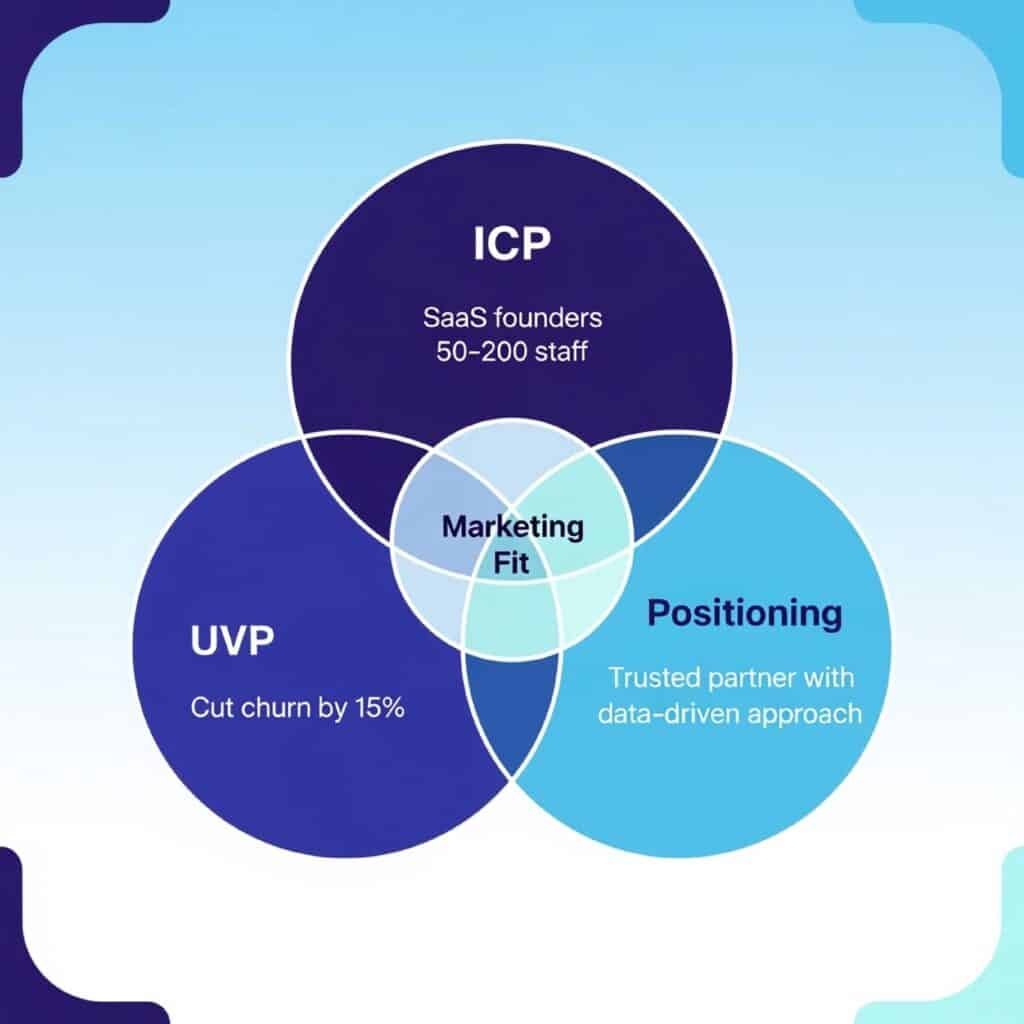
Optimize Your SEO & Website
In SaaS, content problems rarely come from not producing enough. They come from making the wrong things or letting the right things rot over time.
- Most teams publish blogs that generate traffic but don’t align with buyer intent, so visits don’t translate into trials or demos.
- Landing pages often chase broad keywords instead of high-intent terms, leaving money on the table.
- TOFU content gets attention, but MOFU and BOFU content, the comparison pages, case studies, and integration guides that actually push decisions, are either missing or weak.
- And then there’s outdated material: old posts with broken links, screenshots from three versions ago, or content that no longer reflects the product.
In short, the real content problem is misalignment: traffic doesn’t match intent, funnel stages aren’t covered evenly, and assets aren’t kept fresh.
These issues are very common for many businesses. They drag down SEO across the whole domain, and you can spot them early on only if you pay enough attention to regular SaaS marketing audits.
Question 1: Is page speed optimized for mobile and desktop performance?
This means checking how fast your landing pages load on both desktop and mobile devices, because even one second of delay can decrease conversions by 20%.
The easiest tools to use are Google PageSpeed Insights or Lighthouse (built into Chrome DevTools).
Just enter your page URL in PageSpeed Insights, and you’ll see scores for both mobile and desktop, along with specific issues like large images, unused scripts, or slow server response that need fixing.
Question 2: Are there any technical SEO issues, such as crawlability or broken links?
Crawlability is about whether search engine bots (like Googlebot) can move through your site’s pages without barriers. If your robots.txt blocks a page, if links are buried too deep, or if the site structure is confusing, important pages may never be reached. Indexability is the next step. Even if a bot can crawl a page, it won’t show up in search results unless it’s allowed to be indexed. Things like “noindex” tags or duplicate content can prevent this.
To check both, tools like Screaming Frog SEO Spider, Ahrefs Site Audit, or SEMrush Site Audit are the go-to. They simulate how search engines crawl your site, list which pages are blocked or missing, and highlight errors like 404s, redirect chains, or noindex tags that might keep valuable content out of search results.
Question 3: Is there any keyword cannibalization across landing pages or blog content?
Keyword cannibalization happens when multiple pages on your site compete for the same keyword. Instead of boosting your chances, this usually hurts rankings because search engines don’t know which page to prioritize. A common example is when both a blog post and a landing page target “best CRM for small businesses.” The result is that neither ranks as well as it could.
To spot this, use Ahrefs → “Site Explorer” → “Organic Keywords” and filter by keyword. If you see two or more URLs from your domain ranking for the same term, that’s cannibalization.
In SEMrush, the “Position Tracking” tool highlights competing URLs for one keyword. From there, decide whether to merge the content, differentiate the keyword targets, or set one as the clear main page.
Question 4: How is your internal linking structure helping or hindering SEO?
Internal linking is how your pages connect to each other.
Done well, it helps search engines understand which pages are most important and guides users smoothly from one piece of content to the next.
Done poorly, it leaves valuable pages buried too deep, with little chance to rank. For example, if your high-converting comparison page is only linked once in a blog post, Google sees it as less important, and users may never find it.
To check this, use Ahrefs Site Audit → “Internal Link Opportunities” or SEMrush Site Audit → “Internal Linking.” These tools show which pages get too few links, where broken internal links exist, and suggest new link placements.
A practical fix might be linking every product-related blog post back to the main feature page, ensuring authority flows to the pages that drive conversions.
Audit Conversion Rate Optimization (CRO)
CRO is about removing friction between a visitor’s interest and their decision to act. In a SaaS marketing audit, this means checking if the path from curiosity to trial or demo is as smooth as possible.
- Start with your CTAs: are they clear, visible, and placed where users naturally look for the next step? A strong CTA doesn’t hide at the bottom of the page. Instead, it repeats in logical spots, like after value props or pricing tables, so users never have to scroll back to act.
- Next, test your forms: every extra field increases drop-offs, so ask only for what you truly need at the first step, and make sure the design works flawlessly on mobile. To move from guesswork to evidence, use heatmaps and session recordings from tools like Hotjar or Microsoft Clarity; these show where people click, where they hesitate, and where they leave.
- One overlooked area of CRO is remarketing: you may lose 90% of visitors on their first session, but dynamic retargeting ads can bring them back with personalized reminders, driving them directly to the page or offer they last interacted with. A proper CRO audit combines these insights into a prioritized list of fixes with measurable impact.
Audit Analytics & Attribution
Analytics and attribution matter because they show if your marketing actually brings customers. In GA4, you can set up goals and funnels so you see not just who visits your site, but who signs up for a trial, books a demo, or upgrades. This helps you track the real steps people take, not just empty clicks or pageviews.
Then, pay close attention to attribution, which is simply the way you figure out which parts of your marketing helped turn a visitor into a customer. Most people don’t sign up after seeing just one thing.
They might read a blog, watch a video, click an ad, and only later book a demo. Attribution connects those dots so you can see the full path. If you only count the last click before they signed up, you miss the bigger picture of what actually influenced their decision.
That’s why different attribution models exist:
- Last-click shows the final step,
- First-click shows where the journey started,
- Multi-touch spreads credit across every touchpoint.
With the right model in place, you can understand how each part of your marketing works together to bring real customers in.
Making the Audit Actionable: Next Steps
An audit isn’t the finish line; it’s just the map you should use to reach your end goal. What matters is how quickly you act on it.
Here’s how to do it:
- Prioritize by impact vs. effort: Tackle quick, high-impact fixes first (e.g., stop wasted ad spend, fix duplicate events), then plan larger projects like new funnel builds.
- Separate quick wins from growth projects: Quick wins deliver results fast, such as updating CTAs or refreshing a landing page. Growth projects (like new content or multi-touch attribution) take longer but drive lasting performance.
- Assign clear owners: Avoid “the team will handle it.” Every task should have a specific owner (design, product, marketing ops) to ensure execution.
- Set your next audit date: Quarterly reviews work best for fast-moving SaaS. At a minimum, schedule one annually so issues don’t snowball.
- Get support if needed: If your team lacks bandwidth or expertise, a SaaS marketing agency can help operationalize findings, from attribution setups to CRO experiments.
How Can Camel Digital Help?
At Camel Digital, we don’t try to be everything to everyone. Our focus is narrow on purpose: we have been living and breathing B2B SaaS PPC marketing for more than 6 years!
This means if you need a partner to take a hard look at how your paid search and paid social actually perform, where budget is wasted, and how campaigns tie back to sign-ups and revenue, this is where we can help.
We know the mechanics – how to check tracking setups in Google Ads and LinkedIn, how to clean up attribution so the numbers make sense, and how to align ads with the funnel instead of just chasing clicks. We’ve worked with SaaS companies that had very lean budgets and ones with larger spend, so we understand the trade-offs each requires.
Our role in an audit is straightforward: bring clarity to your paid channels, highlight the quick wins that can free up wasted spend, and map out what it would take to make PPC a reliable driver of growth.
No big promises. It’s just clear, actionable work where we know we can deliver. If you want honest insights into your SaaS PPC performance and a plan you can actually execute, that’s exactly what we offer.
